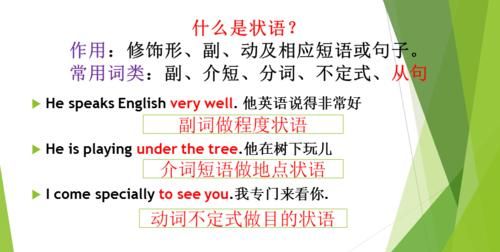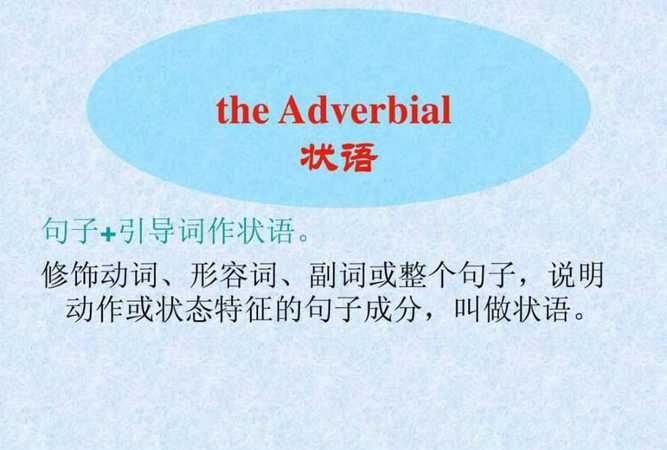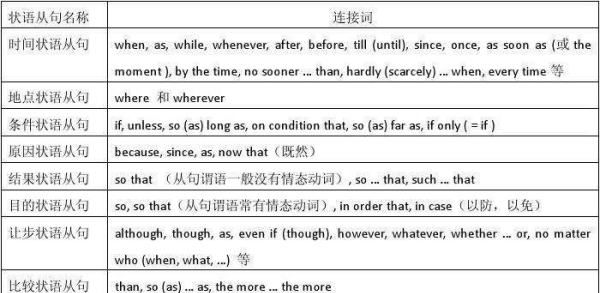本文目录
时间状语从句的特征
1.时间状语
通常由连词或连词短语引导:when/while(当...的时候) as(当...的时候) since(自...从来) as soon as/no sooner...than/hardly...when
scarcely...when...(一...就)whenever(任何时候) before(在...以前) after(在...以后) the mement
Once(一旦) till/untill(直到...才)instantly/immediately(一...就)
一些表示时间的名词词组:
the moment , the minute , the instant , the day , the year , each time, every time, next time , by the time , the first time 等,也可以用来引导时间状语从句,起着引导词的作用
2.地点状语
通常由连词引导:where(在...的地方) wherever(在任何地方) everywhere(在每个地方)
where引导状语从句和定语从句的区别在于 : where引导的地点状语从句可以直接修饰主句的2谓语动词
而定语从句中where要跟在表示地点的先行词后面
Make marks where you have any questions.(状语从句)
Make marks at the places where you have any questions(定语从句)
3.原因状语
通常由连词或连词短语引导:because(因为),as(因为),since(既然,由于),for(由于),in that(由于,因为),now that(既然),now that...but that...(不是...而是..)
强调原因状语从句只能用“ It is/was +because从句+ that +其他”
4.目的状语
通常由连词或连词短语引导:so that(为了,以便) lest(以防,以免)in order that(为了,以便)for fear that(唯恐,以防) in case(以免,以防)
in case意为“以防,以免”时,引导目的状语从句,常含有can,could,may等情态动词;意为“如果,万一”时,引导条件状语从句
5.结果状语
通常由连词或连词短语引导:so that(结果是,以致),so..that...(如此...以至于...)such...that...(如此...以至于..)
so that 即可以引导目的状语从句,又可以引导结果状语从句,区别是
so that既可以引导目的状语从句,又可以引导结果状语从句,区别是:
(1)引导目的状语从句时表示一种 意欲或可能性 ,引导结果状语从句时 表示一种事实 。
(2)so that引导的目的状语从句中常含有can,ould,may, might,will, would等情态动词,而s
that引导的结果状语从句中一般没有情态动词。
(3)so that引导的目的状语从句之前不用逗号,而 so that引导的结果状语从句与主句之间往往用
逗号隔开。如:
She left early so that she could catch the train.(目的)
她动身早,以便能赶上火车。
She left early, so that she caught the train.(结果)
她动身早,结果赶上了火车。
6.条件状语
通常由连词或连词短语引导:if(如果),unless(除非),supposing(假如),providing/provided that(假如),on condition that(如果,条件是),as/so long as(只要),in case(如果)
7.比较状语
通常由连词或连词短语引导:as...as(像...一样),than(比),not as/so...as(不像...一样),not the same/such...as(和...不一样),the +比较急...,the+比较急...(越...,就越...)
(1)as...as,than引导的比较状语从句中常省略和主句相同的部分,只留下相比较的部分。如:
Bill is much taller than his friend(is).比尔比他的朋友高得多
(2)as...as,than引导的比较状语从句中,常用助动词或情态动词的某种形式代替与主句相同的谓
语部分。如:
Jack works as hard as Jim does.(does代替 works)杰克工作和吉姆一样努力
bought fewer books than you did.(did代替 bought)我买的书比你买的少
8.方式状语
通常由连词或连词短语引导:as(按照),(just)as...so(正如...也),as if/though(好像),the way(像...那样,用...的方法)
(1)as if/though引导的方式状语从句可以用陈述语气,表示所说情况是事实货实现的可能性较大 ;可以用虚拟语气,表示不符合事实或与事实相反的情况。如:
He talks as if/though he is drunk.(是事实,从句用陈述语气)
从他谈话的样子来看,他好像喝醉了。
Tom behaved as if/ though nothing had happened.(与过去事实相反,从句用虚语气)
汤姆表现得若无其事。
(2)as if/ though也可以引导表语从句,常与系动词look, sound,em,appear等词连用如
It sounds as if/though they had a good holiday.
听起来他们好像度过了一个愉快的假期。
9.让步状语
通常由连词或连词短语引导:as(尽管)(用倒装结构),though(虽然),although(虽然),while(虽然),even if/though(即使),whatever(无论什么),whichever(无论哪个),wherever(无论哪里),whoever(无论谁),however(无论如何),no matter how/what/where/when(不管怎样/什么/哪里/何时),whether...or not(不管)
“no matter +疑问词”只能引导让步状语从句,而“疑问词+ -ever”即可引导让步状语从句,又可引导名词性从句

英语总动员知新篇状语从句
状语从句指 句子 用作状语时,起副词作用的句子。接下来,我给大家准备了英语总动员知新篇状语从句,欢迎大家参考与借鉴。
英语总动员知新篇状语从句
它可以修饰谓语、非谓语动词、定语、状语或整个句子。根据其作用可分为时间、地点、原因、条件、目的、结果、让步、方式和比较等从句。状语从句一般由连词(从属连词)引导,也可以由词组引起。从句位于句首或句中时通常用逗号与主句隔开,位于句尾时可以不用逗号隔开。
一、时间状语从句
要点: 时间状语从句,由以下连词引导:
when while1 as2 after before as soon as since3 till4 /until5 by the time 在时间状语从句中,要注意时态一致。一般情况下主句是将来时的时候,从句要用一般现在时。
1.when当。。。的时候
Mozart6 started writing7 music when he was8 four years old.
(当)莫扎特的时候,开始写音乐作品。
2.while当。。。时
He visited a lot of places while he was traveling9.
他在旅途中参观了许多地方。
3.as在。。。的同时;一边。。。一边。。。
He smiled as he stood10 up.
他一边站起来一边笑着。
4.after在。。。之后
He left the classroom after he had11 finished12 his homework the other day.
前几天做完作业之后回的家。
5.before 在。。。之前
Mr. Brown had worked in a bank for a year before he came13 here.
布朗先生来这之前已经在一家银行里工作一年了。
6.as soon as 一。。。就。。。
We began to work as soon as we got14 there.
我们一到那就开始工作。
I will write to you as soon as I get home.
我一到家就给你写信。
7.since 自。。。以来 到现在
表示自过去的一个起点时间到目前(说话时间)为止的一段持续时间。主句一般用现在完成时,从句用一般过去时。
Mr Green has taught15 in that school since he came to China three years ago.
自格林先生来中国以来,他就在这所学校教书。
(还可以用作介词,本句从句还可以用 短语 :since three years ago(自三年前以来)表示。)
8 till /until
都可以作连词,连接时间状语,也可以作介词,与 其它 词构成介词短语,在句中作状语。
They walked till /until it was dark16.
他们一直走到天黑。
Xiao Ming didn’t leave home till / until his father came back.
小明直到他爸爸回来才离开家。
9. by the time 到。。。为止 (所在句子的主句应用完成时)
By the time he gets there , his father has already17 gone.
他到家的时候,他爸爸已经走了。
By the time I got to school, the class had already began.
我到校时,已经开始上课了。
难点——as when while的辨析
as when while都表示主、从句动作同时发生,三者差异如下:
表示“一边。。。一边"的意思
as 强调两个动作同时进行,并表示对比时
用于发生时间较段时
when 1、还可以表示从句动词的动作在主几句动词的动作"之前 "或"之后"发生。
2、when=and then; at that moment (正在那个时候)
while 1、用于时间较长时
2、 强调两个动作同时进行,并表示对比时
有时这三个连词可以互换,有时不可以。
lIt was raining hard when (as) I got there.
我到那里时,正在下大雨。 ( 动作同时发生,when可换为as, 但不能换为while,因为get是点动词.)
lWhen I had read the article18, he called me.
我看完这篇 文章 之后,她给我打了电话。( 从句动作发生在主句之前,注意时态表达,只能用when )
lWhen I got to the cinema, the film had begun.
(当)我到了电影院时,电影已经开演了。(从句的动作发生在主句之后,只能用when,并要注意时态)
lHe was about to leave, when the telephone rang.
他正要离开,忽然电话响了。( 此时不能放在句首。主句动词一般表达 “正在” “即将”.
while, as不能代替 ) 考点
lShe thought19 I was talking about her daughter, while, in fact20, I was talking about my daughter.
他以为我在谈她女儿,然而,实际上在谈论我女儿。(表转折,对比,when, as都不能代替它) 考点
lWhile the alien21 was buying a souvenir22, the girl called the police23.
外星人买纪念品时,那女孩给警察打了电话。(表示主句,从句的动作同时发生,while后引导的状语从句的动词必须是延续动词不能是点动词,因为它表示较长时间)考点
lMother was worried24 because little Alice was ill, especially25 as (when/ while) father was away.
妈妈担心,因为小爱丽丝病了,特别是他父亲不在家的时候。(此时as ,when, while可通用)
知识扩展
1. It is since从。。。以来多长时间了(因为since +从句或名词,表示一段时间)
It is five years since we met last time.从我们上次见面已经五年了。
2. It is +before…(。。。才)
It was a long time before I went to sleep again.
过了很长时间我才睡着。
It was an hour before(=until) the police arrived.
过了一个小时,警察才来。
二、条件状语从句
要点: 表示状语从句由连词if, unless26 (=if not) 引导。
1.If it doesn’t rain tomorrow, we will go hiking27.
如果明天不下雨, 我们就去远足.
2.You will get good grades if you study hard.
如果你努力学习,就会取得好成绩.
3.I will go to the party unless he goes there too.
我不会去参加聚会的, 除非他也去.(如果他不去,我也不去.)
4.You will be late unless you leave immediately28.
如果你不马上走,你将会迟到的.(=If you don’t leave immediately, you will be late.)
难点提示:用条件状语从句时要注意时态的正确使用,当主句是将来时的时候,从句要用一般现在时.
lHe will not leave if it isn’t fine tomorrow.
一般将来时, 一般现在时
lThey are going29 to have a picnic if it doesn’t rain next week.
一般将来时, 一般现在时 考点
三、原因状语从句
要点: 由连词because, since, as引导, 也可由for, now that 等词引导
1.I didn’t go to school yesterday because I was ill.
我昨天没去上学,因为我生病了。
2. Since everybody30 is here, let’s begin our meeting31.
既然大家都来了, 让我们开始开会吧.
3. As you are in poor health32, you should not stay up late.
既然你身体不好, 你就不该熬夜.
4.I asked her to stay to tea, for I had something to tell her.
我请她留下来喝茶,因为我有事要告诉她.
.难点——because , since , as , for,辨析
在语气上,because 最重, 表示的是直接理由,回答why 时只能用它. 其次是since, as ,一般不表示原因, 而是表明理由, 进一步说明.(译为:由于,既然). for 被认为是复合句的并列连词(常用于推断),表示理由.
四、地点状语从句
要点: 由连词where和复合关系词wherever (=no matter where )引导.
知识扩展
1.Where there is a will , there is a way.
有志者事竟成。( 谚语 )
1.It will be mixed school where not all the children are disabled.
他将是一所混合式学校,那里的 儿童 并不都是残疾。(在限定性定语从句中对限先行词起限定作用。)
2.Wherever you go , I go too.
无论你到什么地方,我都去。(wherever=no matter where)无论何处,多用于句首。
3.Wherever there is smoke , there is fire.
无风不起浪。(谚语)
4. While she was wondering where to go , she met a policeman.
疑问副词where后跟不定式,构成不定式短语. 考点
五、目的,结果状语从句
要点: 目的状语从句由连词that, so that, so…that , in order that 引导。
结果状语从句由连词( so )that, so…that, such…that, so much/many…that引导。
1.so…that 如此…以至于
The scientist’s report was so instructive that we were all very excited.
科学家的 报告 很有启发性,我们感到很兴奋。
He always studied so hard that he made great progress.
他总是那么努力,结果他取得了很大的进步。
2.so that 以至, 以便
I’ll run slowly so that you can catch up with me. (目的)
我将慢慢跑以至你能赶上我。
I opened the window so that fresh air might come in. (目的)
我把窗户打开以使新鲜空气可以进来。
3. such…that 如此。。。以至
It’s such nice weather that all of us want to go to the park.
天气是如此的好,我们大家都想去公园玩。
4.in order that=so that:为了
We shall let you know the details soon in order that you can/may make your arrangements.
不久我们将会让你知道详情,以便你们能够做出安排。(目的)
难点
+形容词或副词
+形+a(an)+单数可数名词
so +many 或few+复数可数名词 +that
+much或 little+不可数名词
lso that ,such…that 都可以in order that两者皆可引导目的地状语从句和结果状语从句,
当他们引导目的状语从句时,从句的谓语里常常有can, could, may, might, will, would等次。
(见例句 2, 5 )
lso +adj./adv.+ that, such +n.+ that 以上两种句型都表示结果,其中so为副词,后接形容词,副词原型,当可数名词前有many, few;不可数名词前有much, little修饰时,应采用句型:so many (few, much, little )+n. 。 such为形容词, 后只能接名词。这名词既可以地可数的,也可以是不可数的。如果这名词是可数,单数,则必须在名词前敬爱冠词a(an). 常见的形式是:such a (beautiful)garden, such(nice)people.
lThe weather is so nice that I’d like to take a walk.
天气是如此只好,以至于我想去散散步.
lMike is so honest a man that we all believe him.
麦克是如此诚实的一个人,以至于大家都相信他
(=Mike is such an honest man that we all believe him.) 考点
lI’ve had so many falls that I’m black and blue all over.
我跌了很多跤,浑身数摔得清一块紫一块.
lThere are so few notebooks that I can’t give you any.
笔记本 太少了,我一本也给不了你.
lIt is such nice weather that I’d like to take a walk.
天气是如此只好,以至于我想去散散步. 考点
六、让步状语从句
要点: 表示让步的状语从句由连词 though, although引导.
难点:
lthough, although当虽然讲, 都不能和but连用. Although,(though)…but的格式是不对的.但是他们都可以同yet (still) 连用. 所以thought (although)…yet(still)的格式是正确的.
lWrong: Although he is rich but he is not happy.
Right : Although he is rich, yet he is not happy.
虽然他很富有, 然而他并不快乐.
lRight : Although we have grown up, our parents treat us as children.
Right : Although we have grown up, our parents still treat us as children.
尽管我们已经长大了,可是我们的父母仍把我们看作小孩.
although, though 辨析
although 不能though 那样用作副词, 放在句末表示强调时要用even though.
lHe is looking fit, though.
但是,他看上去很健康. 考点
lEven though I didn’t under a word, I kept smiling.
尽管我一个字也不懂,我还是一直微笑着。
lHe is quite experienced1, he is young, though.
尽管他很年轻,他很有 经验 。
七、比较状语从句
要点:比较状语从句主要运用于形容词和副词的原级,比较级及最高级的句子之中。
原级
1. as…as 和。。。一样
Jack2 is as tall as Bob.
捷克和汤姆一样高。
2. not so(as)…as …和不一样
She is not so(as)outgoing as her sister.
她不如她姐姐外向。
比较级
more…than (更)
This book is more instructive than that one.
这本书比那本书由 教育 意义。
最高级
1.The most…in/of
This book is the most interesting of the three.
这本书是三本中最有趣的。
2. the + 形容词+est…of/in
This road is the busiest street in our city.
这条路是我们城市最繁忙的街道。
知识扩展
lno more than只不过(嫌少的意思)
I have no more than two pens.
我只有两支笔。
It’s no more than a mile to the shops.
去商店不过一英里。
lnot more than不如。。。;(前者不如后者)
Jack is not more diligent3 than John.
捷克不如约翰勤奋。
lone4 of the + 名词(复数)….之一(用于最高级)
Han Mei is one of the best students in our school.
韩梅是我们学校最好的学生之一。

定语从句
1、定义不同
定语从句指一个句子跟在一名词或代词(先行词)后进行修饰限定。
宾语从句指在主从复合句中充当宾语,位于及物动词、介词或复合谓语之后的从句。
状语从句指句子用作状语时,起副词作用的句子。
2、引导词不同
定语从句的引导词又称为先行词,一般可以做先行词的单词有:who、whom、 that、which、whose、why、when、where等。
宾语从句的引导词一般为that。
状语从句可以由单词引导,也可以由词组引导,常见引导词为when、where、while、before、as soon as、until、since等。

3、要求不同
定语从句分为限制性定语从句和非限制性定语从句,对引导词有不同的要求,如在非限定性定语从句中,不能用关系副词做主语。
宾语从句则要求语序必须是陈述语序,即:连接代词/副词+主语+谓语+其他成分。
状语从句主要用来修饰主句或主句的谓语。状语修饰动词、形容词、副词或整个句子。通常由副词、介词短语、动词不定式、分词和从句等担当。
九大状语从句 请举例 并说明每句修饰的是什么词
一、时间状语从句
用表示时间的连词连接一个句子作状语,这样的主从复合句就是时间状语从句。连接时间状语从句的连接词有:when, before, after, while, as soon as, until, since...... 这里要注意一点的是,如果主句是一般将来时,从句只能用一般现在时表示将来意义。
二、地点状语从句
地点状语从句表示地点、 方位, 这类从句通常由where、wherever等引导。地点状语从句可置于句首、句中或句尾。
三、原因状语从句
原因状语从句指在句中用来说明主句原因的从句。引导原因状语从句的从属连词有because(因为), as(由于), since(既然), now(that)(既然), when(既然), seeing (that) (由于,鉴于)。
四、条件状语从句
由引导词if或unless引导的状语从句叫做条件状语从句。在英文中,条件是指某一件事情实现之后(状语从句中的动作),其它事情(主句中的动作)才能发生,通常译作“假如”。
五、目的状语从句
目的状语从句:从句部分是用以补充说明主句中谓语动词发生的目的的状语从句。
表示目的状语的从句可以由that, so that, in order that, lest, for fear that, in case等词引导;目的状语从句的谓语常含有may, might, can, could, should, will, would等情态动词。
六、让步状语从句
让步状语从句,是指状语从句中的一种,其本身也是状语从句。一般翻译为“尽管……”或“即使……”,就是我们日常生活中用的“退一步说…”的感觉。
七、比较状语从句
状语从句指句子用作状语时,起副词作用的句子。比较状语从句是其中的一种,主要运用于形容词和副词的原级、比较级及最高级的句子之中。
八、方式状语从句
1、由as, (just) as…so…引导的方式状语从句通常位于主句后,但在(just) as…so…结构中位于句首,这时as从句带有比喻的含义,意思是"正如…","就像",多用于正式文体。
2、由as if 和as though 引导的从句中的时态取决于说话者对所谈内容的态度。若说话者认为其看法是真的或可能会成为事实,从句谓语就按常规变化。
九、结果状语从句
结果状语从句其规律由so与such的不同词性决定。such 是形容词,修饰名词或名词词组,so 是副词,只能修饰形容词或副词。 so 还可与表示数量的形容词many, few, much, little连用,形成固定搭配。
结果状语从句的从句部分是补充说明主句中谓语动词发生的结果的,通常位于主句之后。结果从句中通常不用情态助动词,但must,can,could除外。such用在(形容词)名词之前;而so要用在形容词/副词之前,so或that有时会省略掉。

扩展资料:
1,时间状语从句
When I came into the room,he was writing a letter.
当我进屋时,他正在写信。
2、地点状语从句
Where there is a will,there is a way.
有志者,事竟成。
3、原因状语从句
I came back late yesterday because I was on duty.
昨天我回来晚了,是因为我要值班。
4、目的状语从句
We'll tell you the truth so that you can judge for yourself.
我吧真实情况告诉你,使你自己能做出判断。
5、结果状语从句
It is such an interesting novel that all of us want to read it.
这本书很有趣,大家都想看。
6、条件状语从句
We shall go there tomorrow if it doesn't rain.
如果明天不下雨,我们就去哪儿。
7、方式状语从句
Do as you are told.
按照人家告诉你做的去做。
8、让步状语从句
I'll go even though it rains tomorrow.
即使明天下雨,我也要去。
9、比较状语从句
He bought fewer books than I (did).
她买的书比我买得少。
参考资料:百度百科-状语从句
以上就是关于状语从句长什么样 ,时间状语从句的特征的全部内容,以及状语从句长什么样 的相关内容,希望能够帮到您。

